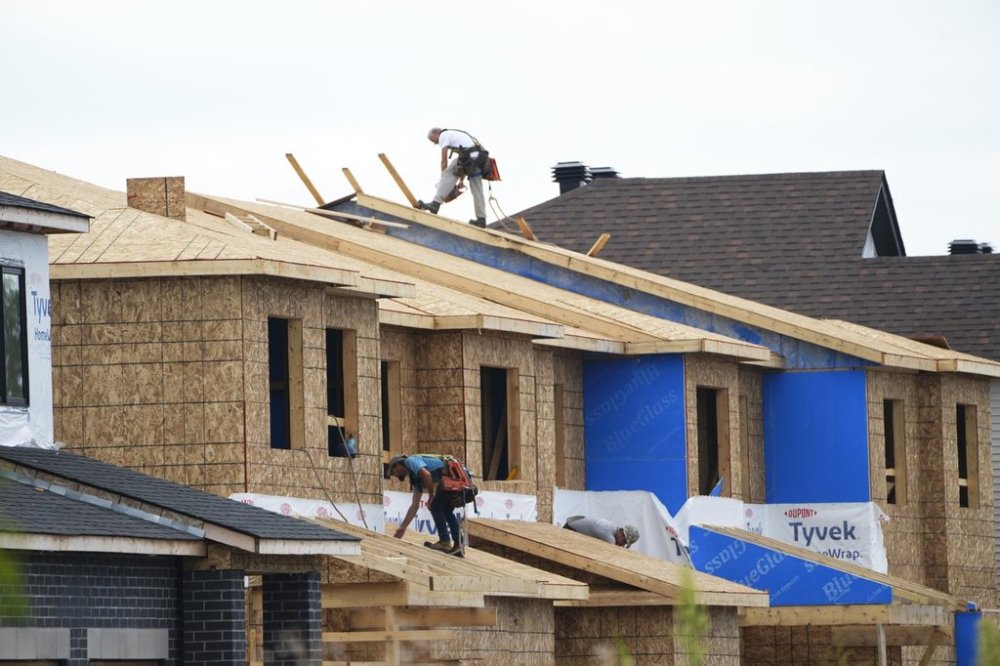Eliminating interprovincial trade barriers would add 30K annual housing starts: CMHC
Advertisement
Read this article for free:
or
Already have an account? Log in here »
To continue reading, please subscribe:
Monthly Digital Subscription
$0 for the first 4 weeks*
- Enjoy unlimited reading on winnipegfreepress.com
- Read the E-Edition, our digital replica newspaper
- Access News Break, our award-winning app
- Play interactive puzzles
*No charge for 4 weeks then price increases to the regular rate of $19.00 plus GST every four weeks. Offer available to new and qualified returning subscribers only. Cancel any time.
Monthly Digital Subscription
$4.75/week*
- Enjoy unlimited reading on winnipegfreepress.com
- Read the E-Edition, our digital replica newspaper
- Access News Break, our award-winning app
- Play interactive puzzles
*Billed as $19 plus GST every four weeks. Cancel any time.
To continue reading, please subscribe:
Add Free Press access to your Brandon Sun subscription for only an additional
$1 for the first 4 weeks*
*Your next subscription payment will increase by $1.00 and you will be charged $16.99 plus GST for four weeks. After four weeks, your payment will increase to $23.99 plus GST every four weeks.
Read unlimited articles for free today:
or
Already have an account? Log in here »
A new analysis by the national housing agency estimates Canada could add 30,000 more housing starts annually by eliminating interprovincial trade barriers.
That would push the total number of annual housing starts close to 280,000 over time, which would represent a “meaningful step towards fixing Canada’s housing supply gap,” Canada Mortgage and Housing Corp. said in a report Thursday.
CMHC chief economist Mathieu Laberge said to achieve this, Canada must reduce interprovincial constraints holding back west-to-east transportation infrastructure, which would help maximize the use of domestic materials across the country.

“Removing the barriers creates this general economic wealth that would make it easier to trade across partners in a country,” Laberge said in an interview.
“That would raise the economy, make it stronger overall, and that would benefit housing construction as a result.”
He said fewer interprovincial trade barriers would strengthen the economy in several ways by driving up demand for home ownership, including through a stronger overall economy, a lower unemployment rate and higher household incomes.
“Since increased income is expected to increase demand for home ownership, housing supply must increase to at least match the increase in demand in order to maintain or improve affordability,” the report said.
“It is also expected that the average rent will go up 3.1 per cent, about half the increase in incomes. Rental housing market affordability will improve since incomes will be growing faster than rents.”
The report’s projections would represent close to 15 per cent of the additional housing supply needed annually over the next decade to return to pre-pandemic affordability levels, according to recent CMHC estimates.
Last month, CMHC said up to 4.8 million new homes will need to be built over the next decade to restore affordability levels last seen in 2019 based on projected demand. That would mean between 430,000 and 480,000 new housing units are needed per year across the ownership and rental markets by 2035 — around double the current pace of home construction in Canada.
CMHC projects an average of 245,000 starts annually over the next 10 years under current conditions.
Eliminating interprovincial trade barriers was a focal point of Prime Minister Mark Carney’s campaign during the spring federal election, when he vowed to create “free trade by Canada Day.”
His government has since passed Bill C-5, an omnibus bill that reduces federal restrictions on interprovincial trade while speeding up permitting for large infrastructure projects.
Experts have said that law is only the first step of the process as it deals with red tape put up by the federal government, rather than rules set by the provinces, which have the most authority in this area.
The Canadian Federation of Independent Business has estimated that existing internal trade hurdles cost the economy some $200 billion a year.
“There are a number of trade barriers that prevent the movement of either resources or labour in the residential construction industry,” Laberge said.
“There are, for example, different standards for different inputs to the residential construction industry … The flip side is the labour side, the service side, where we do see that some of the agreements still isolate residential construction labour.”
Laberge’s report cited a survey by Statistics Canada showing close to half of Canadian construction firms blame distance and transportation costs as the main reasons for not purchasing goods or services from suppliers in another province or territory.
They also say provincial or territorial tax laws are part of the problem, in addition to difficulties obtaining permits and licenses, among other challenges.
The report said Canada has “ample domestic production” of core construction resources, noting it is a net exporter of materials such as wood, aluminum, iron and steel.
“That means the country doesn’t use all that it produces, and a significant share of our domestic production could be redirected towards residential construction in Canada,” he said.
This report by The Canadian Press was first published July 17, 2025.

